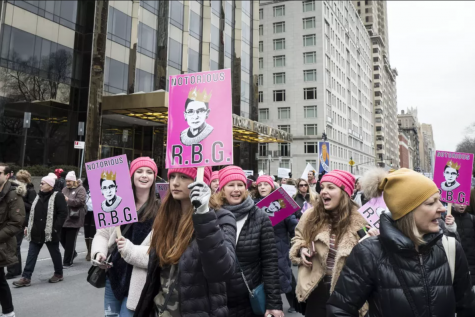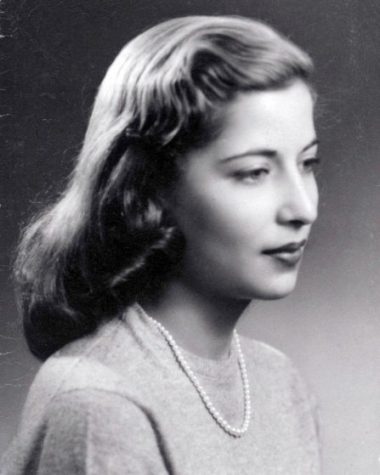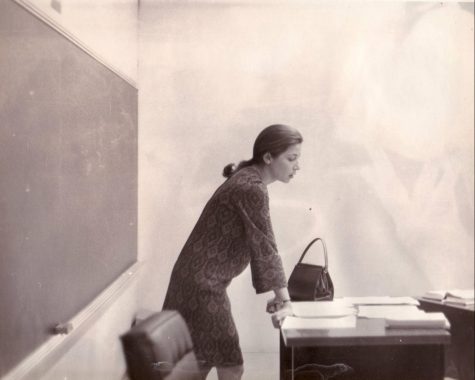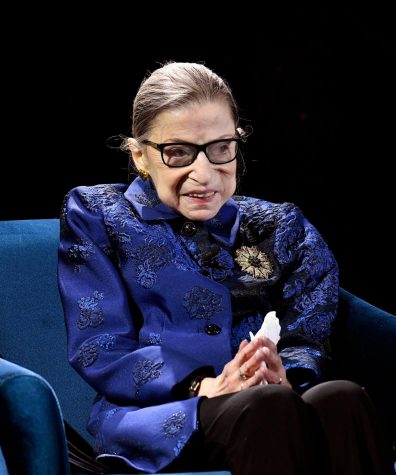The Life and Legacy of Ruth Bader Ginsburg
October 5, 2020
Ruth Bader Ginsburg, Supreme Court Justice and female rights icon, died at the age of 87 on September 18 due to complications from metastatic pancreatic cancer. She died surrounded by her family at her home in Washington D.C., according to a statement from the Supreme Court. Ginsburg was known for her powerful dissenting opinions, which earned her the name “the Notorious RBG”, a play on the name of the Notorious BIG, a rapper. Ginsburg’s work as a lawyer and Supreme Court justice has allowed women many rights and has given women a voice on their quest for equality.
Demonstrators hold up “Notorious R.B.G.” signs at the 2019 Manhattan Women’s March (Image Credit: Ira L. Black/ Corbis via Getty. Images) (Courtesy of Mashable) (Ira L. Black/ Corbis)Ruth Bader Ginsburg was born Joan Ruth Bader in Brooklyn, New York, on March 15, 1933. She was born to a Jewish family and lived in a low-income, working class neighborhood. Ginsburg attended James Madison High School, where she worked hard and excelled in her academics. Her mother, a main influence in her life, had been battling cancer during Ruth’s high school years and died on the day before Ginsburg’s high school graduation.

Ruth finished first in her graduating class at Cornell University in 1954. The same year, she married Martin D. Ginsburg. The couple moved to Fort Sill, Oklahoma, so Martin could complete his military service. Two years later, they both attended Harvard Law School, where Ruth was one of only nine women in a 500 person class. During her years at law school, she had to care for her 3-year-old daughter and her husband, who was diagnosed with testicular cancer. She still was able to succeed academically, and transferred to Columbia Law School, after her husband recovered from cancer and graduated.
Ginsburg graduated from Columbia at the top of her class in 1959. However, finding a job was hard for Ginsburg because she was not only a woman, but also a mother, a factor which deterred many employers.
She finally found work as a clerk for the New York judge Edmund Palmieri. She got the job after her professor Gerald Gunther, who sent his best students to Palmieri, told the judge that if he didn’t take Ginsburg, Gunther would never send Palmieri a clerk again and said that if she couldn’t do the work, he would send another clerk who could. Ginsburg’s clerkship to Palmieri was successful, and he employed her for two years (1959-1961) instead of the typical one year that his clerks worked for.
In 1963, Ginsburg was given a job as a teacher at Rutgers Law School, where she started fighting gender discrimination. She taught at Rutgers until 1972, when she got a job teaching at Columbia University Law School, becoming the school’s first female tenured professor. She worked at Columbia until 1980.

Ruth Bader Ginsburg wrote her first Supreme Court brief in 1971, in the case of Reed v. Reed. In this case, Ginsburg represented Sally Reed, a woman who felt that she should be the executor of her son’s estate instead of her ex-husband. Ginsburg filed an 88-page brief in this case, which consisted of all the ways in which the law helped to reinforce society’s oppression of women. Though she lost this case, she went on to argue many more gender equality cases of this proportion.
While teaching at Columbia, Ginsburg also served as the director of the newly-created Women’s Rights Project of the American Civil Liberties Union (ACLU). She argued six landmark cases on gender equality before the Supreme Court during her time at the ACLU.
Ginsburg was named to the U.S. Court of Appeals for the District of Columbia Circuit in 1980 by President Jimmy Carter. 13 years later, in 1993, Ginsburg was nominated to the Supreme Court by President Bill Clinton. She was the second woman and the first Jewish female appointed to the Supreme Court.

On the Supreme Court, Ginsburg was considered a moderate liberal, though she and conservative justice Antonin Scalia were close friends.

Ginsburg argued many cases on gender discrimination, as well as other forms of discrimination, and fought through five battles with cancer. Even when her husband, Martin, died, she was on the bench of the Supreme Court the next day, reading an opinion she had written for the Court.
Ginsburg had recently suffered another battle with cancer this year, and died on September 18, after 27 years of service on the Supreme Court.

Judge Amy Coney Barrett, a judge in the U.S. Court of Appeals for the Seventh Circuit, was nominated by President Donald Trump to replace Justice Ginsburg. This nomination has stirred up controversy, because it comes 38 days before the 2020 presidential election, some saying that the process is being rushed.
Ginsburg’s courage and strength has helped women and other minorities in gaining many rights. Her work will affect generations to come. She is an inspiration and her legacy will live on in the Supreme Court and across the world.
To learn more about Justice Ginsburg’s opinions, concurrences, and dissents on the Supreme Court, visit the Cornell Law School’s Legal Information Institute (LII) website.
https://www.nytimes.com/2020/09/26/us/politics/amy-coney-barrett-supreme-court.html
https://www.history.com/topics/womens-history/ruth-bader-ginsburg
https://www.cnn.com/2013/03/07/us/ruth-bader-ginsburg-fast-facts/index.html
https://www.nytimes.com/2020/09/18/us/ruth-bader-ginsburg-dead.html
